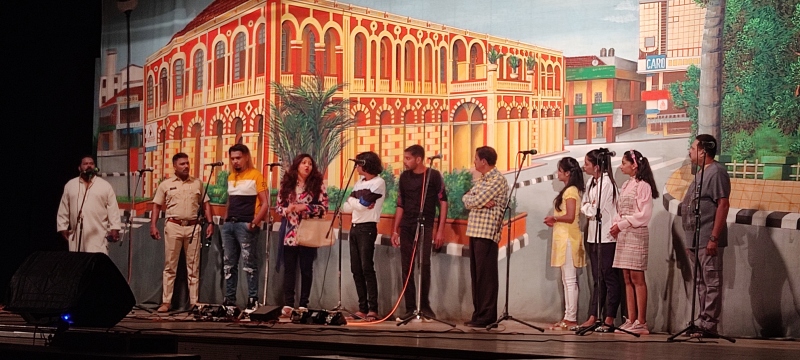The college tiatr competition reminded us that even theatre can be made relevant and attractive to the young generation

Many Goans like us easily buy into the propaganda that the tiatr in Goa is sub-standard entertainment, imitative, lacks originality, and even borderline indecent. But, if you open up your mind, you might see a different reality out there.
In the past fortnight, this columnist spent six afternoons watching the 4th college tiatr competition. Like a Bollywood film, a Konkani tiatr is not a hurried affair. Seven acts ('podde') and 13 songs means you can expect to spend at least three hours time in a go.
The tiatr is a roller-coaster ride of emotions. One moment you're following a tragic story. Soon, the comedian (and there are a growing number of comediennes too) is making you laugh your guts out, with a loud and almost slapstick brand of humour.
The collegians too put up some good and memorable shows. If you forgot for a while that they were only students, they would seem like professionals doing their best.
Two things are striking about the collegians going on to the stage. Firstly, they are so confident and effective when the curtain raises. Goan students, who can be a quiet lot in the classroom, who mostly like to stay silent when the teacher or professor is around, become uber-confident. What accounts for this transformation? They sing and act with fluency, excepting the rare messing up of a line or two in a song, which, of course, is to be expected.
Secondly, their creative juices really flow. With some help from their professors or guides (this is allowed as per the rules, and it makes sense if the goal is to improve standards), the students put up some thought-provoking themes in act and song.
Contrary to the local elites who shun the grassroots-up tiatr, scholars working on the field (late Pramod Kale, Andre Rafael Fernandes) have found something different. If you see the way this born-in-Bombay, and now promoted-in-Goa theatre form manages to stay relevant and active, it's easy to realise why it works.
Hardworking groups of tiatrists put up an impressive job in making tiatr viable. From a backstage perspective, you can see how hurriedly they set up their props, move from one venue to another (even when long distances are involved across Goa in the world of professional tiatr). This, despite the little, if any, support from the State, which is otherwise quick to offer doles when it wants to influence various media.
The college tiatr competition also brought home other lessons. It reminded us that even theatre can be made relevant and attractive to the young generation. The determination with which they staged their shows, only showed that.
Some tiatrs were written by young teachers and priests, who because they're not much older than the students, perhaps also understand the youth culture of today. This could help bridge the age gap, and reduce the feeling that our media (mainstream and otherwise) does too little for our youth.
What struck one was also the powerful message that the tiatr stage could portray. The themes were often relevant to our youth and our times. These included themes of marital breakdowns in our divorce-prone world, selfish and selfless values among young people today, or the need of parental affection.
Parents were reminded why children should be given the liberty to choose their own careers and paths ahead. Some songs focussed on the contributing of a dad in the upbringing of their child. Others spoke of traditional lifestyles in our fast-changing Goan times. Pre-marital sex and its consequences was the theme for one set of students at an age when these could be important issues for them.
Each of the six participating colleges had their own strengths, and did put their best foot forward. Dempo Commerce had some real good acting, and a neat storyline too. Xavier's had their comedian Ryan virtually bring down the house, after putting up a great show at last year's competition. Their band was also locally built, which is to be appreciated. Carmel's had some great singing. The audience appreciated Fr Milton sfx's storyline present as part of the Pilar College show. And Pilar's higher secondary put up an appreciated show, despite being the youngest set of participants around.
What is the government's approach towards the tiatr? Luke warm, if anything. In the past, certain politicians discouraged prominent halls from being used for tiatr shows, on the grounds that the audiences were unruly -- which just seems like bias.
Kala Academy, Goa, set up its Theatre Arts Faculty in 1987, and now has its own School of Drama. But that seems to be doing little to promote forms like the tiatr. Last year, in 2023, the Kala Academy's School of Drama put up a well-appreciated tiatr at the college contest. It was performed well, and so were some of its song-dance sequences. But this time, this college was not represented.
If young dramatists find tiatr largely missing, underplayed or dismissively treated in their syllabus, what is the message being sent out? What does it do to the perceptions about Goa's most lively and viable threatre form? This brings us to a related question. Tiatr has a fair amount of young actors. It has young musicians too. But where are the young tiatr audiences?
Now, the challenge is to take tiatr to the next generation. Youngsters have so many digital distractions to pay attention to. Maybe, for the mainstream tiatrs, students below a certain age could be given sharply discounted tickets to attend. Once they start watching, they're sure to enjoy and get hooked. It is perhaps also time for tiatr organisers and performers to get more creative in their use of the social media, so that their work .on the stage can also be visible in the online world.